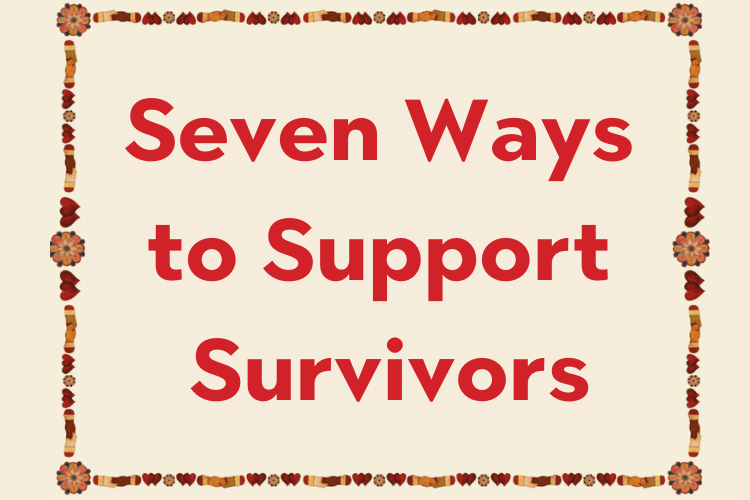
Seven Ways to Support Survivors
Because one in three women has experienced sexual trauma, supporting them is a matter of both public health and social justice. Here are some ways to create more safety and compassion.
1| BELIEVE US.
In order to dismantle the patriarchy and the ways in which it perpetuates sexual violence, we need to listen to and believe survivors, particularly women of color. The more we normalize sharing our experiences of sexual violence, the sooner we end cycles of shame, secrecy, assault, and abuse.
2| ASSUME THAT EVERYONE IS A SURVIVOR.
Because one third of women have experienced sexual trauma, you are likely to interact with multiple survivors every day. Whether she’s your Starbucks barista, your annoying colleague or your quirky cousin, be kind to her. Be patient and gentle. Giving survivors some grace and the benefit of the doubt provides us with some much-needed space for healing.
3| GIVE PEOPLE SPACE TO MAKE THEIR OWN CHOICES.
All survivors have the common experience of not being in control of our bodies for at least one moment in our lives. To counteract this experience of losing control, you can use your language to affirm and reinforce each person’s capacity to choose what to do with their bodies and when. This applies to both your personal and professional lives.
Some examples of choice-affirming language include:
“I support whatever feels right for you.”
“Please take as much time as you need.”
“We can either do X or Y—what works best for you?”
4| LET IT BE OKAY FOR PEOPLE TO DO THINGS DIFFERENTLY FROM WHAT YOU WANT OR EXPECT.
If you’re going to empower others to make their own choices, you’ll need to accept the fact that people will show up differently from each other and not conform to behavioral standards. If you’re a yoga teacher, for example, this might mean that your student curls up on the ground to write in her journal instead of doing tree pose; if you’re a professor, this might mean that a student submits the assignment via video rather than essay (or doesn’t submit the assignment if she’s struggling with her mental health); and if you’re a facilitator, this might mean that someone chooses to pass on the icebreaker question because she’s doesn’t feel comfortable sharing with a large group. Allowing for a variety of movements, expressions, and communication styles, without judgment, helps cultivate the autonomy and trust that many survivors want and need.
5| LEARN HOW TO REGULATE YOUR NERVOUS SYSTEM.
One of the best ways that to create safe spaces for people living with trauma is noticing when your own nervous systems are overactivated/dysregulated, and learning how to rebalance. This could mean going for a walk after a tough conversation, pausing to breathe before speaking, or eating lunch with a friend in the middle of a stressful work day. It’s deeply reassuring to be in the presence of someone who’s able to regulate themself.
6| DON’T FLIPPANTLY REFER TO SEXUAL VIOLENCE OR INCORRECTLY USE THE TERM PTSD.
It can debilitating for survivors to hear about sexual violence when we’re not expecting it. So use a content warning and/or ask for consent if you want to discuss it. And when you use the term PTSD, please make sure that you’re referring to the actual medical condition so that you’re not diminishing the hardships and lived experiences of those of us living withactual PTSD.
7| WHEN IN DOUBT, LEAD WITH LOVE.
Whether you’re a survivor or not, life is tough. Love is redeeming. When in doubt, lead with love and approach interactions with an open heart. Survivors will thank you for it.
Halli Faulkner is an online yoga therapist. You can find her at www.hallifaulkner.com.






